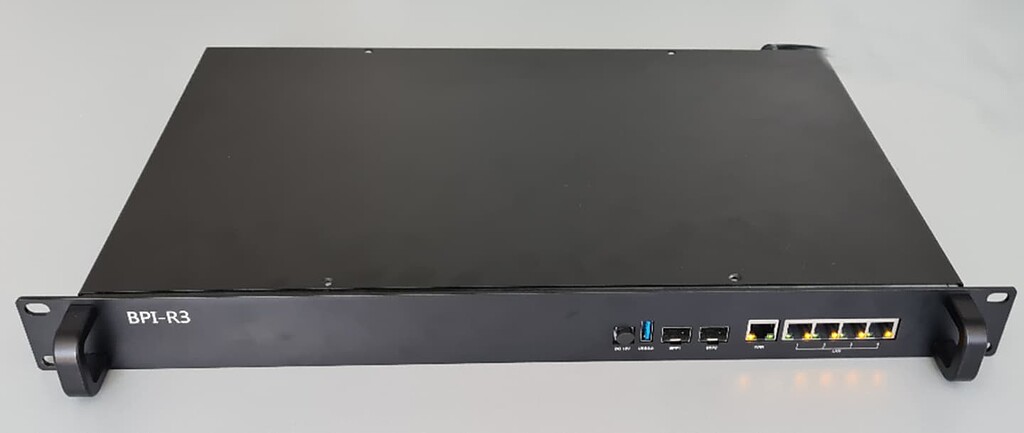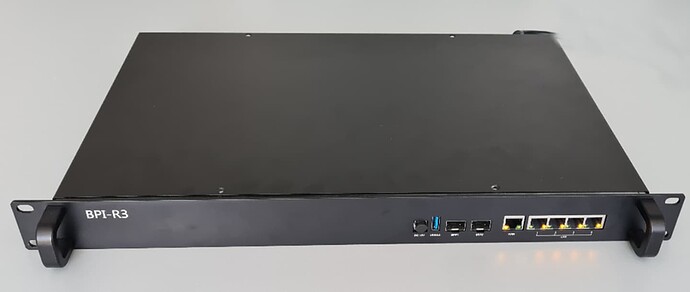Navigation
App installieren
So wird die App in iOS installiert
Folge dem Video um zu sehen, wie unsere Website als Web-App auf dem Startbildschirm installiert werden kann.
Anmerkung: Diese Funktion ist in einigen Browsern möglicherweise nicht verfügbar.
Weitere Optionen
Style-Variante
Du verwendest einen veralteten Browser. Es ist möglich, dass diese oder andere Websites nicht korrekt angezeigt werden.
Du solltest ein Upgrade durchführen oder einen alternativen Browser verwenden.
Du solltest ein Upgrade durchführen oder einen alternativen Browser verwenden.
Bastelempfehlung FTTH + WiFi + Ethernet + OpenBSD?
- Ersteller dettus
- Erstellt am
dettus
Bicycle User
Danke. Ich hab das Teil aber gerade so schoen auf meinem Schreibtisch liegen.Klingt blöd, aber die entsprechenden AMD64 Systeme kriegt man inzwischen mit echt viel Leistung für unter 150 aus China inkl. Zoll.
Der Stromverbrauch ist inzwischen auch echt niedrig. @dettus - dafür lohnt es sich kaum mit ARM rumzubasteln.

double-p
BOFH
[[ Mit ARM bekommt man non-AMD Bugs (siehe latest defcon SMM ..) ;-) ]]
@dettus an der stelle (nach den kernel numbers) switched der output (auf com0) und das hast
du dann so nicht im capture, der kernel laeuft aber normal weiter hoch - nur siehst du
halt keine moeglichen folge fehler zB beim switch auf init (no root?).
@dettus an der stelle (nach den kernel numbers) switched der output (auf com0) und das hast
du dann so nicht im capture, der kernel laeuft aber normal weiter hoch - nur siehst du
halt keine moeglichen folge fehler zB beim switch auf init (no root?).
Dazu finde ich den Transparenz-Bericht von Posteo (ja kein ISP) immer interessant, wie viele Ersuche wohl nicht formal korrekt sind. Ob die jeder Service Provider immer so im Detail prüft.....?(Soweit ich weiß geben ISP seit der DSGVO Daten NICHT mehr einfach so an behören weiter wenn die nicht irgend einen Richterlichen Beschluss haben - der ist teilweise natürlich sehr leicht zu bekommen, aber doch noch schwieriger nen einzelner Polizist der da böse guckt oder ne Privatfehde hat oder so wie es ja in der Vergangenheit auch mal vorgekommen ist.
E-Mail grün, sicher, einfach und werbefrei - posteo.de - Transparenzbericht
Posteo ist ein innvovativer E-Mail-Anbieter, der auf Nachhaltigkeit und Datenschutz setzt und komplett Werbefrei ist. Unsere E-Mail-Postfächer, Kalender und Adressbücher sind synchronisierbar - wir setzen auf umfassende Verschlüsselung.
dettus
Bicycle User
Das kann sein... Wie soll ich dann die Frage nach dem (I)nstall, (U)pgrade (S)hell beantworten?[[ Mit ARM bekommt man non-AMD Bugs (siehe latest defcon SMM ..) ;-) ]]
@dettus an der stelle (nach den kernel numbers) switched der output (auf com0) und das hast
du dann so nicht im capture, der kernel laeuft aber normal weiter hoch - nur siehst du
halt keine moeglichen folge fehler zB beim switch auf init (no root?).
dettus
Bicycle User
BOOYAKASHA!
Auf der arm@openbsd Mailingliste konnte mir jemand helfen.
Ich konnte mit einem .dtb File aus sysutils/dtb weiterkommen.
Damit lief es dann:
Jetzt kommt der spassige Teil: Ich muss das noch dokumentieren.
Die kaputten Bytes am Ende kommen daher, dass der UART irgendwann von 115200 auf 230400 Baud wechselt. (Warum auch immer...)
Aber das ist schon wieder eine Sackgasse, denn er findet weder Netzwerkdevices noch die SD-Karte.
Auf der arm@openbsd Mailingliste konnte mir jemand helfen.
Ich konnte mit einem .dtb File aus sysutils/dtb weiterkommen.
Code:
pkg_add dtb
mount_msdos /dev/sd10l /mnt/
cp /usr/local/share/dtb/arm64/mediatek/mediatek/mt7986a-bananapi-bpi-r3.dtb /mnt/
umount /mnt/Damit lief es dann:
Jetzt kommt der spassige Teil: Ich muss das noch dokumentieren.
Code:
fit=bpi-r3.itb
Failed to load 'bpi-r3.itb'
BPI-R3> fatload mmc 0:5 0x46000000 /efi/boot/bootaa64.efi
227979 bytes read in 18 ms (12.1 MiB/s)
BPI-R3> fatload mmc 0:5 0x47000000 mt7986a-bananapi-bpi-r3.dtb
18144 bytes read in 3 ms (5.8 MiB/s)
BPI-R3> bootefi 0x46000000 0x47000000
Booting /\efi\boot\bootaa64.efi
disks: sd0*
>> OpenBSD/arm64 BOOTAA64 1.18
boot> ls
drwxr-xr-x 0,0 512 .
drwxr-xr-x 0,0 512 ..
drwxr-xr-x 0,0 512 7.5
-rw-r--r-- 0,2000 18362795 bsd
-rw-r--r-- 0,2000 18362795 bsd.rd
-rw-r--r-- 0,0 18362795 bsd.mine
drwxr-xr-x 0,0 512 7.3
drwxr-xr-x 0,0 512 7.4
-rwxr-x--- 0,0 17566884 bsd.new
boot> set console tty
set: syntax error
boot> stty com0 115200
boot> boot bsd.rd
cannot open sd0a:/etc/random.seed: No such file or directory
booting sd0a:bsd.rd: 3023768+1214656+12712936+633232 [269381+91+701664+287051]=0x13edb50
Copyright (c) 1982, 1986, 1989, 1991, 1993
The Regents of the University of California. All rights reserved.
Copyright (c) 1995-2024 OpenBSD. All rights reserved. https://www.OpenBSD.org
OpenBSD 7.5 (RAMDISK) #124: Wed Mar 20 20:05:58 MDT 2024
deraadt@arm64.openbsd.org:/usr/src/sys/arch/arm64/compile/RAMDISK
real mem = 2141806592 (2042MB)
avail mem = 2035232768 (1940MB)
random: boothowto does not indicate good seed
mainbus0 at root: Bananapi BPI-R3
psci0 at mainbus0: PSCI 1.1, SMCCC 1.2, SYSTEM_SUSPEND
efi0 at mainbus0: UEFI 2.10
efi0: Das U-Boot rev 0x20240700
smbios0 at efi0: SMBIOS 3.7.0
smbios0: vendor U-Boot version "2024.07-rc3-mt7986-43599-gbc68f3572ff" date 07/01/2024
smbios0: mediatek BananaPi BPi-R3
cpu0 at mainbus0 mpidr 0: ARM Cortex-A53 r0p4
cpu0: 32KB 64b/line 2-way L1 VIPT I-cache, 32KB 64b/line 4-way L1 D-cache
cpu0: 512KB 64b/line 16-way L2 cache
cpu0: CRC32,SHA2,SHA1,AES+PMULL,ASID16
"ramoops" at mainbus0 not configured
"secmon" at mainbus0 not configured
"wmcpu-reserved" at mainbus0 not configured
"wo-emi" at mainbus0 not configured
"wo-emi" at mainbus0 not configured
"wo-ilm" at mainbus0 not configured
"wo-ilm" at mainbus0 not configured
"wo-data" at mainbus0 not configured
"wo-dlm" at mainbus0 not configured
"wo-dlm" at mainbus0 not configured
"wo-boot" at mainbus0 not configured
"oscillator-40m" at mainbus0 not configured
agtimer0 at mainbus0: 13000 kHz
simplebus0 at mainbus0: "soc"
agintc0 at simplebus0 shift 4:3 nirq 672 nredist 4: "interrupt-controller"
syscon0 at simplebus0: "infracfg"
syscon1 at simplebus0: "wed-pcie"
syscon2 at simplebus0: "topckgen"
syscon3 at simplebus0: "syscon"
syscon4 at simplebus0: "syscon"
syscon5 at simplebus0: "syscon"
syscon6 at simplebus0: "wed"
syscon7 at simplebus0: "wed"
syscon8 at simplebus0: "syscon"
syscon9 at simplebus0: "syscon"
"watchdog" at simplebus0 not configured
"apmixedsys" at simplebus0 not configured
"pinctrl" at simplebus0 not configured
"rng" at simplebus0 not configured
"crypto" at simplebus0 not configured
"pwm" at simplebus0 not configured
com0 at simplebus�: ns16550a, 16 byte fifo
com0: console
com1 at simplebus0: ns16550a, 16 byte fifo
com2 at simplebus0: ns16550a, 16 byte fifo
"i2c" at simplebus0 not configured
"spi" at simplebus0 not configured
"spi" at simplebus0 not configured
"usb" at simplebus0 not configured
"thermal" at simplebus0 not configured
"pcie" at simplebus0 not configured
"t-phy" at simplebus0 not configured
"efuse" at simplebus0 not configured
"t-phy" at simplebus0 not configured
"ethernet" at simplebus0 not configured
"wifi" at simplebus0 not configured
"regulator-12vd" at mainbus0 not configured
pwmfan0 at mainbus0
"gpio-keys" at mainbus0 not configured
"i2c-gpio-0" at mainbus0 not configured
"i2c-gpio-1" at mainbus0 not configured
"leds" at mainbus0 not configured
"regulator-1p8v" at mainbus0 not configured
"regulator-3p3v" at mainbus0 not configured
sfp0 at mainbus0: can't get i2c bus
sfp1 at mainbus0: can't get i2c bus
softraid0 at root
scsibus0 at softraid0: 256 targets
root on rd0a swap on rd0b dump on rd0b
WARNING: CHECK AND RESET THE DATE!
���c���d��Ɔ��d����*�+�c��k� �b��DŽ䄆d�'���Edg�הƄ懤���bF������������Ć����Ƈ
(I)nstall, (U)pgrade, (A)utoinstall or (S)hell?Die kaputten Bytes am Ende kommen daher, dass der UART irgendwann von 115200 auf 230400 Baud wechselt. (Warum auch immer...)
Aber das ist schon wieder eine Sackgasse, denn er findet weder Netzwerkdevices noch die SD-Karte.

dettus
Bicycle User
So, ich habe eine Anleitung geschrieben.
Ich habe sie in ein anderes Forum gestellt:
https://forum.banana-pi.org/t/bpi-r3-how-i-was-able-to-boot-openbsd-7-5-and-failed/18770
Ich habe sie in ein anderes Forum gestellt:
https://forum.banana-pi.org/t/bpi-r3-how-i-was-able-to-boot-openbsd-7-5-and-failed/18770

Ebenso eine gute alternative das BPI-R4 (in 19" Rack):

 forum.openwrt.org
forum.openwrt.org

 forum.banana-pi.org
forum.banana-pi.org

Banana Pi BPI-R3/R4 19" rack system enclosure
for all people who are interested in a rack enclosure system, I have had a sample produced The front panel is removable and can be replaced with a BPI-R4 panel at any time. Furthermore, a board can also additional be installed on the left side (e.g. for redundancy). Then there is a front...
 forum.openwrt.org
forum.openwrt.org

Banana Pi BPI-R3-R4 19” rack case enclosure
for all people who are interested in a rack enclosure system, I have had a sample produced The front panel is removable and can be replaced with a BPI-R4 panel at any time. Furthermore, a board can also additional be installed on the left side (e.g. for redundancy). Then there is a front...
 forum.banana-pi.org
forum.banana-pi.org
Ich versuche das möglichst umzusetzen, weshalb ich irgendwann mein NFS Share auf Zugriff mit sshfs umgestellt habe. Das ist aber deutlich langsamer und kommt vermutlich nicht so gut mit mehreren Benutzern klar.Ich würde meine Zeit und Energie eher in Zero Trust Security investieren:
Das Gedankenmodell mein eigenes LAN ist sicher stammt noch aus einer Zeit unverschlüsselter Verbindungen und M2M-Vertrauensmodellen auf IP-Basis (NFS lässt grüßen).
Im fremden WLAN könnte doch eine VPN Verbindung zum Heimrouter automatisch wieder mehr Sicherheit herstellen, nicht wahr?Wenn ich mir die bekanntgewordenen Vorfälle der letzten Jahre so anschaue (inklusive Fällen wie der Edathy-Affäre), nichts davon wäre durch einen eigenen Router abgefangen worden.
Betrachte einfach jedes Netzwerk (auch das heimische) als potenziell unsicher und du bist auf deutlich mehr Bedrohungsszenarien vorbereitet. Spätestens der eigene Laptop hängt im Normalfall früher oder später mal an einem WLAN-Hotspot.
Anmerkung zur Leistung der PCengines APU2:
Ich betreibe eine apu2e4, welche meiner Ansicht nach das leistungsfähigste Modell der apu2 Reihe sein müsste. Die CPU ist nämlich auch bei den "Nachfolgermodellen", wie auch der Version mit SFP Port die gleiche. Aber die 1G Base-T Netzwerkchips sind i210AT, welche 4 TX/RX queues implementiert, im Gegensatz zum i211AT Chip, welcher nur 2 queues hat. Keine Ahnung, ob das in der Applikation als Router besonders relevant ist.
Betriebssystem: OpenBSD
Seit einiger Zeit betreibe ich einen 500Mbit/s G.fast Anschluss mit einem solchen System. Der Downstream durch den Router ist tatsächlich langsamer, als das was das Draytek Modem liefern könnte. Effektiv bekomme ich dadurch in den meisten Situationen auf ca. 400Mbit/s Downstream.
Ich finde die Leistung für meine Zwecke immer noch als ausreichend, auch wenn damit wirklich eine Grenze erreicht scheint.
Als Nachfolger kommen für mich als Coreboot Fan die Geräte von Protectli (insbesondere die äußerst teuren Geräte mit SFP+ Port) oder vielleicht sowas hier in Frage:
Die APU wird mir aber noch einige Zeit lang ausreichen.
roema
Well-Known Member
Ich habe nun meine APU ersetzt mit einem N100 mini Computer von Aliexpress, das läuft sehr gut mit opnsense. (Ich hoffe das ist ok wenn ich einen link poste, soll keine Werbung sein)
Die gibt es auch mit SFP. Preislich sind sie sogar günstiger als eine komplette APU damals.
Der Stromverbrauch ist natürlich etwas mehr und sie wird auch einiges wärmer.
Die gibt es auch mit SFP. Preislich sind sie sogar günstiger als eine komplette APU damals.
Der Stromverbrauch ist natürlich etwas mehr und sie wird auch einiges wärmer.
jmt
Well-Known Member
Wie warm wird er denn? Und kannst Du vielleicht auch sagen, wieviel Strom er verbraucht?Ich habe nun meine APU ersetzt mit einem N100 mini Computer von Aliexpress, das läuft sehr gut mit opnsense. (Ich hoffe das ist ok wenn ich einen link poste, soll keine Werbung sein)
Die gibt es auch mit SFP. Preislich sind sie sogar günstiger als eine komplette APU damals.
Der Stromverbrauch ist natürlich etwas mehr und sie wird auch einiges wärmer.
Ich hab son Ding mit N100 beruflich gekauft für ein kleines Projekt und ich bin auch sehr zufrieden.
roema
Well-Known Member
Muss sagen, dass die Performance wirklich super ist. Habe einen ubiquiti Access Point dran und schaffe im Erdgeschoss rund 550MBit/s.Ich hab son Ding mit N100 beruflich gekauft für ein kleines Projekt und ich bin auch sehr zufrieden.
Man merkt deutlich auch im Gui, dass alles viel flüssiger läuft.

